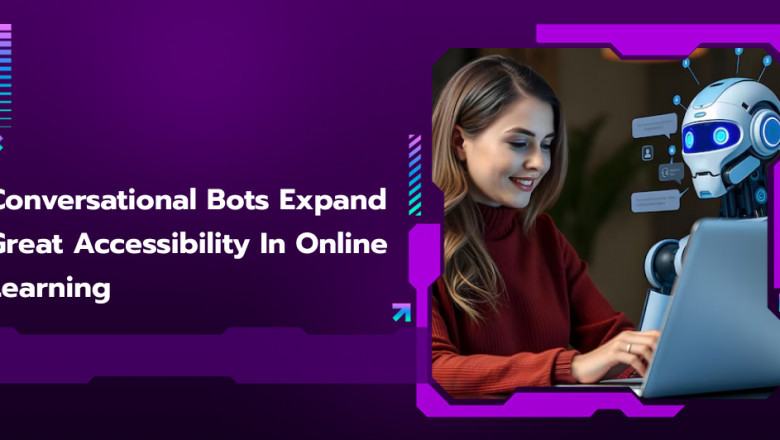views
Introduction
Online learning is completely changing the scope of education with flexibility and scalability never before used in learning. One of the challenges to be addressed is accessibility as well as engagement with diverse learner groups. These are such areas where Conversational Bots, Voice AI, and AI Call Assistant are proving to be transformational. With their intelligent use of enhancing communication, automating various tasks, and putting every student through consistent academic support, they are exactly what today's digital classrooms should offer.
Students are now able to learn via such technological innovations as AI Phone Call, Call AI, and AI voice Agents. Anytime and anywhere, students are guaranteed instant access to platforms used by educational institutions. Answer questions, schedule classes, or share feedback: everything an AI Call Assist, AI Caller, and AI Call Bot can do is made possible under these access gaps while institutions are scaling.
Great Accessibility
Probably one of the most powerful impacts of Conversational Bots in education is increasing accessibility. These AI-man-oriented systems know no traditional barriers to interaction and assistance to make learning more inclusive and responsive.
1. Anytime, Anywhere Support for Every Student
While there are Conversational Bots and Voice AI systems always providing AI Phone Call for students' benefit even during non-instructional hours, they are available whenever students need help from AI Call Assistants and AI voice agents—not just when staff are available for direct assistance.
By using AI Call Assist and Automate Phone Calls, the institutions initiate real-time, continual interaction that makes students feel cared for. This could often help students for whom time zones might act as barriers to successful learning or who simply have a different schedule.
2. Multilingual and Inclusive Communication
Voice AI and Conversational Bots have made language unimportant. They can communicate in different languages and connect culture with inclusion. An AI Phone Call through AI Call Bot can deliver messages either translated or in an optimized voice.
AI Caller tools and AI voice Agents make learning available to students with disabilities through the provision of speech-to-text and text-to-speech supplies. Dynamic content adaptation through the platforms of Call AI and AI Call Assistant yields an extremely personalized, extremely inclusive learning experience for students of all abilities.
3. Scalable Interaction and Outreach
It is a challenge for an educational system to have individual attention for a large number of students. But now, with Automate Phone Calls and AI Call Assist tools, this is now possible. With the help of Voice AI and AI Call Bot, schools can broadcast messages, reminders, and quizzes to thousands without losing personalization.
With Call AI, AI Caller, and AI Phone Call solutions, it is then possible for educators to target outreach based on learner behavior or need. These are possible with Conversational Bots that would initiate the interaction, attend to responses, and escalate to humans for very complex queries, thereby making scaled interaction a reality.
Instant Access to Student Reports
AI-powered facilities are not just devices used to improve communication; they are also the facilities that make it easier for educators to access and analyze data about student performance. AI Call Assistants and Voice AI present real-time feedback to facilitate quicker and more accurate decision-making.
1. Automated Performance Updates
Through AI Phone Call, students receive performance metric updates during scheduled check-ins, while teachers receive snapshots of such information in real time through AI Call Assist. Conversational Bots feed all this data into custom-made learning progress reports.
Call AI and AI voice Agents allow even large classes to be managed well. Alerts are generated through AI Caller platforms for struggling students to ensure timely intervention. Manual reporting is greatly reduced by the kind of instruments like AI Call Bot and Automated Phone Calls, which also provide more transparency between students and educators.
2. Coherent Analytics with Voice AI
The combination of Voice AI systems with AI Call Assistants allows educational platforms to track activity engagement, understanding of materials, and the frequency of interaction. This will personalize students' learning experiences with institutions.
From AI Phone Call and AI Caller tools, parameters on engagement can be drawn from voice-interaction interactions. AI voice Agents will then interpret those parameters to learn gaps in education. AI Call dashboards supported by AI Call Assist will offer an easy-to-use interface to follow up on student progress over time.
3. Prompt Alerts and Feedback
AI Call Bot and AI Call Assist technologies, by default, notify students and teachers when their performance dips. These notifications can happen in real time through either an AI Phone Call or a Conversational Bot-handled message.
AI Caller systems and Voice AI platforms analyze sentiment and hesitation in interactions, which can inform the instructors about how confident a student feels and their comprehension level. Institutions can use Call AI and Automate Phone Calls to provide timely nudges, corrective messages, or schedule additional sessions for the learner whenever required.
Conclusion
The integration of both Conversational Bots, Voice AI, and AI Call Assistants is changing the face of online learning in addressing critical areas such as accessibility and engagement. Among the many features of these technologies in democratizing education, exciting things are added to make it more inclusive, efficient, and responsive to the learning needs of diverse constituency learners.
With around-the-clock help from AI Phone Call services, real-time administrations using AI Call Bot, and inclusive communication by AI Caller and AI voice Agents, these devices are constructing smarter learning environments. And with Automate Phone Calls, personalized outreach using Call AI, and the list goes on, the education system becomes much more proactive, data-driven, and equitable.
Institutions can innovate to not only bring about improvements in learning but also ensure that no student is left behind because of distance, language, or ability to learn.













Comments
0 comment